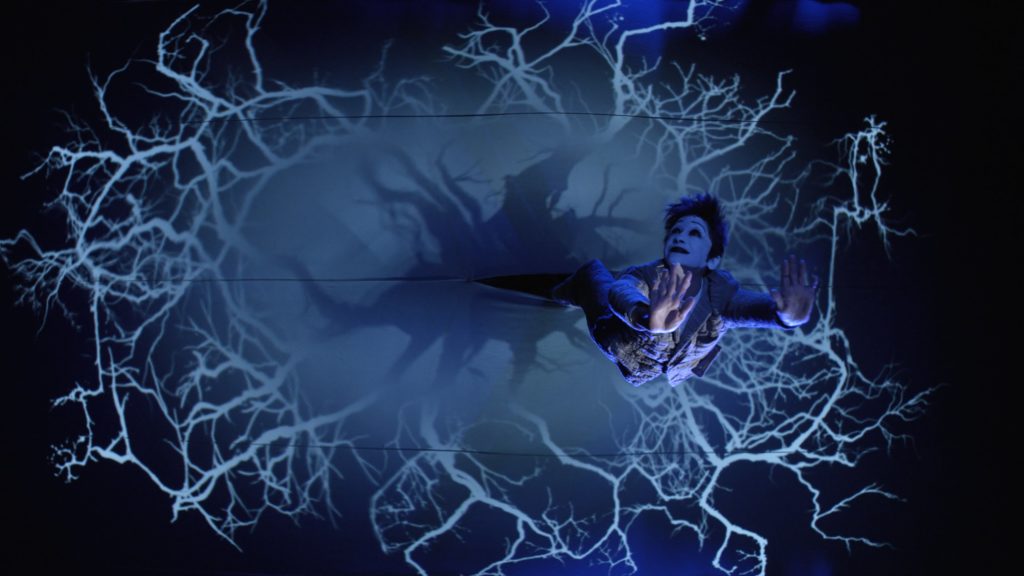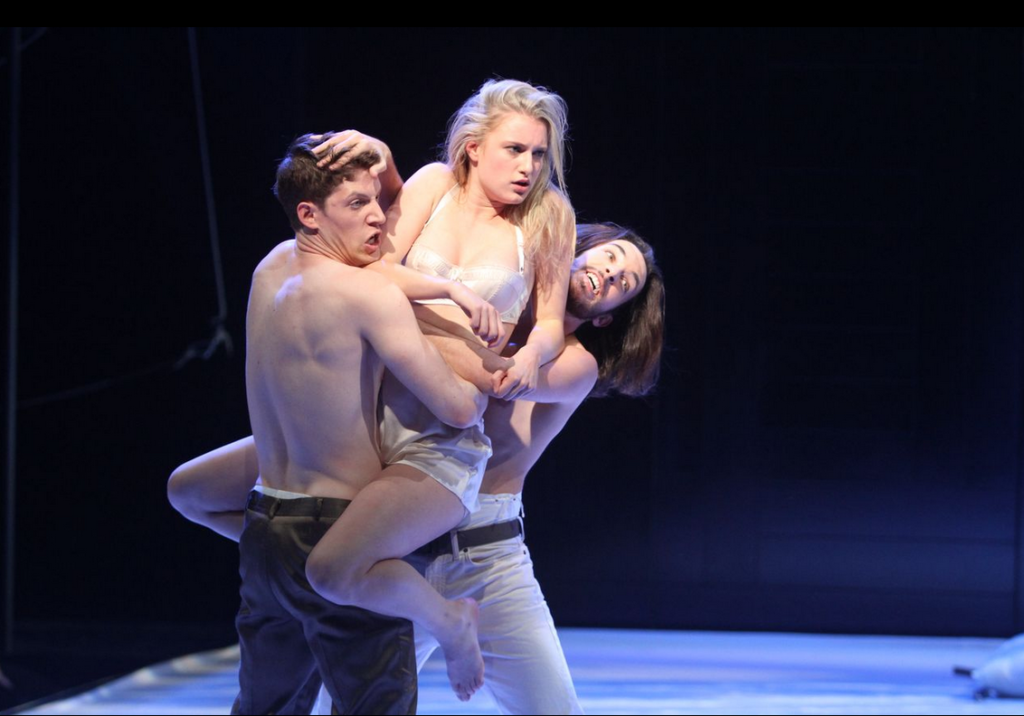Julie Taymor Adapts Shakespeare in a Stunning Fusion of Stage and Screen
Director: Julie Taymor/2014
Street Date: June 20, 2017/Kino Lorber
 Julie Taymor (Frida, Titus, Across the Universe) is not an understated director. Whether directing theater, opera or film, Taymor believes in the spectacle, in creating a work that will have the audience gasping in astonishment. Most famously, Taymor elicited gasps with the Broadway production of The Lion King, earning a Tony in 1998 for Best Direction of a Musical (the first women to win the award).
Julie Taymor (Frida, Titus, Across the Universe) is not an understated director. Whether directing theater, opera or film, Taymor believes in the spectacle, in creating a work that will have the audience gasping in astonishment. Most famously, Taymor elicited gasps with the Broadway production of The Lion King, earning a Tony in 1998 for Best Direction of a Musical (the first women to win the award).
Shakespeare and Julie Taymor go way back. In 1984, Taymor directed a 60-minute version of A Midsummer Night’s Dream for the Theater for a New Audience. 30 years later she was back with the same theater company in a longer, far more elaborate production – one that allowed Taymor’s flair for visual expermination to shine. Almost on a whim and with only a couple of days to prepare, Taymor partnered with cinematographer Rodrigo Prieto (Frida, Argo, The Wolf of Wall Street) to film this version of A Midsummer Night’s Dream, and the result is magical.
 A Midsummer Night’s Dream is one of Shakespeare’s most popular plays; a strange, scary, beautiful, funny tale of humans and fairy creatures, all gobsmacked by love. As Julie Taymor herself points out in an interview included on the Blu-ray, the raw material of the play’s beginning hardly seems ripe for comedy. An Athenian ruler prepares to marry the Amazonian queen he’s defeated in battle. A nobleman tells his daughter that if she doesn’t marry the man of his choosing she will either be killed or forced into a convent. Even the play-within-a-play (a common device for Shakespeare) seems more suited to a tragedy, echoing Romeo and Juliet’s double suicide.
A Midsummer Night’s Dream is one of Shakespeare’s most popular plays; a strange, scary, beautiful, funny tale of humans and fairy creatures, all gobsmacked by love. As Julie Taymor herself points out in an interview included on the Blu-ray, the raw material of the play’s beginning hardly seems ripe for comedy. An Athenian ruler prepares to marry the Amazonian queen he’s defeated in battle. A nobleman tells his daughter that if she doesn’t marry the man of his choosing she will either be killed or forced into a convent. Even the play-within-a-play (a common device for Shakespeare) seems more suited to a tragedy, echoing Romeo and Juliet’s double suicide.
But everything potentially dark or sad is somehow turned upside down in A Midsummer Night’s Dream, leaving the characters with their happy endings, even if the whole thing is pure fantasy. “Are you sure that we are awake? It seems to me that we sleep, that we dream,” a character says at the play draws to an end. And he’s right. A Midsummer Night’s Dream is a daffy, delirious vision – and all the more so in the hands of Julie Taymor, who fills the stage with fantastic costumes, masks, shadow plays, and phantasmagorical video projections. Star crossed young lovers Hermia and Lysander leave Athens and run away together into woods that are part of another kingdom entirely, ruled by fairy queen Titania and her lover, Oberon, King of Shadows.
Titania (Tina Benks) is a shimmering white vision, while Oberon (David Harewood, dominating the stage) is painted jet black with gold stripes across his bare chest. Taymor cast 17 children of various ages as the fairies of the woods, “the Rude Elementals”. They often serve as obstacles to the young lovers, wielding bamboo sticks as trees, or rolling across the ground that Hermia and Lysander try to traverse. As much fun as Titania and Oberon may have with the humans in their forest, they have their own problems with love. Puck, Oberon’s faithful sidekick, tries to straighten things out with a magical flower, but only succeeds in making the wrong people fall in love – including leaving Titania infatuated with a vain actor with the head of a donkey.
 The winding, whimsical plot of A Midsummer Night’s Dream needs to be seen rather than described, and this Blu-ray release is an excellent way to see it. The troupe of actors who stage the play within the play, “the Rude Mechanicals” are hilarious, particularly Nick Bottom (he of the donkey head), played by Max Casella as a Brooklyn wiseguy who can’t resist being the center of attention. The four young people who will be sorted into proper couples by the play’s end seem a bit vapid at first, but over time even that feels right. It’s fitting that Lysander seems so callow, that Hermia is a spoiled daddy’s girl, that Helen and Demetrius spend so much energy pursuing unrequited love. Perhaps people haven’t changed much since Shakespeare’s time.
The winding, whimsical plot of A Midsummer Night’s Dream needs to be seen rather than described, and this Blu-ray release is an excellent way to see it. The troupe of actors who stage the play within the play, “the Rude Mechanicals” are hilarious, particularly Nick Bottom (he of the donkey head), played by Max Casella as a Brooklyn wiseguy who can’t resist being the center of attention. The four young people who will be sorted into proper couples by the play’s end seem a bit vapid at first, but over time even that feels right. It’s fitting that Lysander seems so callow, that Hermia is a spoiled daddy’s girl, that Helen and Demetrius spend so much energy pursuing unrequited love. Perhaps people haven’t changed much since Shakespeare’s time.
The standout performance is surely Kathryn Hunter as Puck. Hunter is tiny, nimble, and extremely flexible. She soars (literally, on harnesses), gambols, and creeps. Sometimes this Puck is graceful, sometimes weirdly spiderlike. With an androgynous style, rasping voice, and clown makeup, Hunter may be the Puck against which all future Pucks will be measured.
 Credit for this production’s success must go in part to Elliot Goldenthal, who composed a spellbinding score for the play; and Rodrigo Prieto deserves much praise. He used four camera operators at each of four shows, resulting in sixteen different camera angles. In between evening productions, the play was performed with cameras on stage, allowing for close ups. These strategies mean that watching the Blu-ray is like having “all the best seats in the house”, as Taymor says, and even more. It’s a clever fusion of live theater and cinema, beautiful to look at and listen to. Perhaps Puck is right that mortals are fools when it comes to love, but there’s real genius behind this kind of artistic endeavor.
Credit for this production’s success must go in part to Elliot Goldenthal, who composed a spellbinding score for the play; and Rodrigo Prieto deserves much praise. He used four camera operators at each of four shows, resulting in sixteen different camera angles. In between evening productions, the play was performed with cameras on stage, allowing for close ups. These strategies mean that watching the Blu-ray is like having “all the best seats in the house”, as Taymor says, and even more. It’s a clever fusion of live theater and cinema, beautiful to look at and listen to. Perhaps Puck is right that mortals are fools when it comes to love, but there’s real genius behind this kind of artistic endeavor.
Kino Lorber’s new Blu-ray release has exquisite color and rich sound, although it’s light on bonus features. There are a few short “making of” featurettes, including a charming one on the process of working with the children cast as the Rude Elementals.

